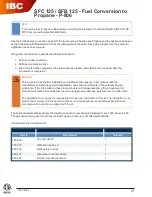
17
M. Internal
Inspections
1. Purpose of Inspections
Internal boiler inspections are required to check the
structural integrity of the boiler shell and look for scale
accumulations inside the boiler.
2. New Boiler Inspection
Make the initial inspection of a new boiler within 30 days
of start-up. Depending on the condition of the boiler at
this time, have a second inspection in six months or less.
The results of these internal inspections can be used to
set a time interval for future internal inspections.
3. In Service Boilers
The time between inspections will vary from 180 days to
one year. This depends on the amount and the quality of
the boiler feedwater, and also on how the boiler is being
used. If the boiler uses large quantities of untreated hard
water, the boiler may need to be inspected every 60
days. If the boiler uses minimal quantities of make-up
water (i.e., closed loop systems) and the water is treated,
the boiler may need to be inspected only once a year.
Many state and/or city codes require annual internal
boiler inspections.
4. Gaskets
The hand hole gaskets and the McDonnell Miller head
gasket must be replaced after each internal inspection.
If any leaks are present around the gasket surfaces,
replace the gasket immediately. High pressure water
and steam leaks will erode the metal surfaces and
cause damage to the boiler which will require expensive
repairs. Keep a full set of hand hole gaskets and a
McDonnell Miller head gasket in stock at all times.
5. Sight
Glass
A sight glass with gaskets and washers should be kept
in stock. Replace the sight glass with new gaskets and
washers on a regular basis.
6. Thermocouples
For boilers with standing pilots, keep a thermocouple in
stock at all times. Lattner uses nickel-plated
thermocouples to withstand high temperatures.
Thermocouples for water heaters are NOT adequate
substitutes.
7. Routine
Service
These standard maintenance items are considered
routine and are not covered under warranty.
















































